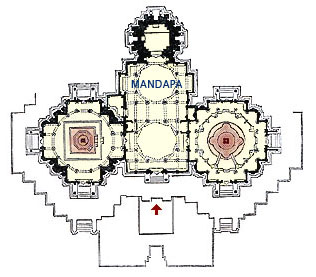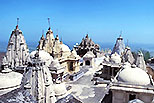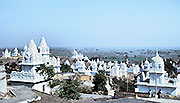|
JAINA TEMPLE CITIES
|
TAKEO KAMIYA
|
JAINA TEMPLE CITIES
|
During the three months of my first trip in India eighteen years ago, each day was filled with new wonder and discovery. Besides India's unique customs and practices, I was often dumbfounded by its architectural scene that was totally different from the one I knew in Western countries and in Japan. Above all, it was the "temple city" on Mount Shatrunjaya in West India that astounded me so strongly. I took a tonga (horse cart) to get to the base of the mountain located about 2km from the town of Palitana in Gujarat State. It was before dawn when I arrived there, and people such as monks, pilgrims and sweepers had already started to climb. After walking up the desolate mountain for two hours, where hardly any trees except cactuses were to grow, I finally reached the summit and found a breathtaking sight in front of me. It was such a fantastic spectacle of some 920 temples jostling each other as if to cascade down from the peak of the mountain.
 SITE PLAN of the Temple City on Mt. Shatrunjaya On this holy mountain, there is nothing but the temple complexes, which were dedicated to one of the 24 "Tirthankaras" (Jinas) respectively. Monks and pilgrims start to climb up at sunrise and go down before sunset. During the four months of the rainy season in which mountain trails become unsafe, the whole mountain is closed and it turns into a ghost town. This temple town consists of north and south ridges and a valley between them. A cluster of temples is called a "tuk." Each tuk has surrounding high walls, thus forming a stronghold. There are six tuks along the north ridge, which includes Kharataravasi Tuk. The valley holds two tuks; Motishah and Balabhai. The entire south ridge forms a single tuk that is called Vimalavasi Tuk.

When passing through a gate of the Vimalavasi tuk along the south ridge, there is a main street that has variously sized temples on both its sides. This sequence of the temples with such a great variety reminds us of Mediterranean villages. At the end of the main street, there stands the Adishwara temple, which is now far more beautifully maintained than any other temples. Lively pilgrims gather and sing sacred songs here. On the contrary, the group of temples along the north ridge is quiet, as if it has been forgotten. Most temples on the mountain are "shikara style," which is characteristic of Northern India. It is an overwhelming sight to see a myriad of both large and small shikaras stand together. What distinguishes these temples from those in Khajuraho is the roof of the mandapa (hall). The hipped roof, which is slanted 45 degrees, is called a "sambarana roof." It is covered with small decorative elements like bells that are turned upside down. We cannot say when these temples started to be built on this mountain. In regard to the Adishwara temple, it is said that they constructed it in 960 and reconstructed it in 1530. Since Jainas not only maintain temples, but also restore, rebuild and extend them incessantly, it is very difficult to specify their age of construction. It is quite probable that half of these temples were built in modern times, and the number of temples in the medieval period was much smaller.

Jainas constructed these kind of "Temple Cities" on various mountains in India, though they differ in scale. Even though Parasnath Hill (Sammetashikhara), where many Tirthankaras are said to have attained nirvana is located in East India, most temple complexes such as Sonagiri and Muktagiri are in West India. It is Mt. Girnar situated 3km east from the town of Junagadh that is as important as Mt. Shatrunjaya in terms of architecture. Pilgrims who ascend this mountain have by far a harder time than with Mt. Shatrunjaya. There is a rock stairway of 3,500 steps that is chiseled out of a precipitous cliff at the rocky mountain. To reach the summit, it is necessary to climb another 1,000 steps. By the time one finishes the painstaking ascent, legs can become shaky and one might feel extremely exhausted.

The landscape after the arduous climbing is extremely fascinating. Although the number of temples is far smaller than at Mt. Shatrunjaya, the sight of these temples standing on a 650m cliff reminds us of a space station in a SF film or the Guell Park made by Antonio Gaudi. It is because most of these mandapas do not have samvarana roofs, but domical ones, and they are also covered with vivid, whitish tile mosaics. Since this mountain is situated in a semi-desert region with little precipitation, it is not possible to obtain stone of good quality. Likewise, the temples at Mt. Shatrunjaya were constructed with porous, coarse sandstone. They become blackish when exposed longterm to rain and wind. Since the weathering is so conspicuous, most temples were plastered and painted.
  Left: A temple of twin domes, Girnar Right: A small isoleted shrine At Girnar, on the other hand, a new method was developed that consisted of finishing the domical roofs, which are most likely to become soiled, with mosaics that are capable of retaining their brightness almost indefinitely. There are even some experimental temples with all the walls and towers also totally covered with mosaics. The method of using mosaic seems to be quite suitable to the climate, but actually it is not so long ago that this technique was put into practice. Chuta Ito, a Japanese architect, visited these temples about 100 years ago. Pictures he took, however, do not reveal the existence of mosaics on these domes. Perhaps mosaics were added in the beginning of the 20th century. Presently, B.V. Doshi, an architect in Ahmadabad, actively employs the method of covering vaulting with mosaics. The oldest temple at Mt. Girnar is the Neminatha temple, a majestic piece of architecture built in 1128. On its east side, there is the Parshvanatha temple (*1), which has a unique plan. The basic structure is ordinary [garbhagriha + mandapa]. However, there are two shrines on both sides of the mandapa. Under each domical ceiling, there is a three-tiered platform and a "Chatrumukha" (four faced) shrine is placed on its top. They represent Mt. Meru and Parasnath Hill. If pilgrims go around and climb on these platforms one by one and pay a visit to the statues of Tirthankara at its summit, they are able to accumulate as many good deeds as if they went on a pilgrimage to the holy mountains.
  Miniature of "Mount Mer" in the Parshvanatha temple Why were Jainas so enthusiastic about building "Temple Cities" on the mountains? For one thing, it would be because of their worship toward mountains. From ancient times, mountain worship has been popular in India, and people liked to design temples in the image of a holy mountain as a residence of Gods. It is represented by Mt. Meru, which is said to be the center of the universe, or Mt. Kailasa, which is believed to be the residence of Shiva. Besides these legendary mountains, Jainas made much of going on a pilgrimage to actual holy mountains and regarded it as a pious deed. Thus they had built temples at such holy places or "tirthas" (*2) from ancient times. For another, it was in order to escape from attacks by heathens. Ever since the attacks by Mahmud of Ghazna in the 11th century, Muslims had destroyed a lot of temples of Jainism, Hinduism and Buddhism. If we regard these attacks as religious persecution, we might be rather wide of the mark. In general, Islam had been tolerant toward other religions. However, it is usual for winners of wars to plunder the land that they have conquered by military force, and in actual terms, Muslims needed to secure places for their religious worship. They dismantled accordingly the stone temples situated in the places they had vanquished and reused the components to build new mosques. As mosques are basically pillared halls, Jaina temples which had a lot of pillars were quite suitable. The mosques in Ajmer, Delhi, and Ahmadabad are typical examples of it. Since Islam strictly prohibits idolatry, they scraped off only engravings of idols on pillars and beams in these mosques. Nevertheless, as the basic formation and domical ceilings of Indic manner still remain, these pieces of architecture clearly show the features of the Jaina and Hindu temples.

As a result most large Jaina temples in Northern India were destroyed, so old temples no longer exist in major cities. Jainas thus chose places deep in the mountains to construct new temples in expectation that there was a small possibility of destruction. However, invasions by the Kharji Dynasty of Delhi and other Muslims had reached Mt. Shatrunjaya, and the temples had been often demolished. It was not until the 16th century when Akbar of the Mughal Dynasty implemented a tolerant policy with other religions in India that peacetime was finally realized. The reason why each tuk had been surrounded like a stronghold was to defend itself from those attacks. However, since Hindu temples had also been destroyed, it does not explain completely why Jainas had made the temple cities on the mountains. In fact, the majority of temples existing at Mt. Shatrunjaya were built during the 18th to 19th centuries, when there was no fear of destruction.

Jainas had a mentality of yearning for remote places deep in the mountains. It is, so to speak, a thought of detachment from the world. From ancient times, there has been in India an inclination to regard this world as a place of suffering. They have also believed in the concept of "Samsara" (transmigration), which means that a life of each person does not end only one lifetime, and we have to return to the world to live a life of affliction again. Furthermore, nobody knows if we will be able to reincarnate as human beings again in our next lives. Depending on a degree of "Karma" (deed), which each person accumulates by the time of death, one might become a beast or an insect hereafter. It means that even ants or spiders around us could be reincarnations of our deceased fathers or mothers in our past lives. How can we stamp on them without consideration? Followers of Jainism, who have been holding such views toward life and ethics most strongly, have tried to lighten their karma by revering all living beings based on the principle of "ahimsa" (non-violence). Rachel L. Carson (1907-64), who in her book "Silent Spring," accused chemical fertilizers and pesticides of destroying the order of nature by killing birds, animals as well as plants. When she wrote the book, which has been regarded as a bible of environmental issues, her mentality was quite close to that of Jainas. However, in pursuit of these environmental issues, we will come to realize that not only chemical fertilizers but also mankind itself is "kow-gai" (a public nuisance or pollution in Japanese) for animals and plants. The fundamental spirit of Jainism is to quit being a pollutant for nature. The reason for not eating meat is to avoid killing animals. They also avoid destroying plants as much as possible, and shun eating roots, which are the source of vegetable lives. They make it a rule to eat only during daytime for fear of killing small insects together with foods when eating in a dark place. In order to abstain from a satiated eating habit, they observe a fast in certain periods. The ultimate ideal for Jainas is a voluntary death by a fast at a remote and immaculate place in the mountain. (*3)

Hide Kishida, a Japanese psychiatrist claims that human beings are animals whose instinct is out of order. As long as living beings in nature live in accordance with their instinct, there is a certain order of peaceful coexistence. However, human beings have a disposition to deviate from nature, which decisively separates mankind from other animals and plants, and cannot but make themselves "kow-gai" for others. That is the original sin of human beings, and because of it they have been causing so many troubles to animals and plants on the earth. It would be the time for human beings to "withdraw" from the earth voluntarily. Those who have already come into being are able to live out their allotted span of lives. However, if we stop making children, true peacetime will come, and an earthly paradise will be realized, when the last remnant of human kind leaves the earth. It seems to me that Jainism has been suggesting such a view since 2,500 years ago.
|